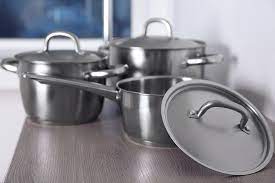Understanding the Difference Between Toxic and Non-Toxic Cookware
In recent years, the awareness surrounding kitchen safety and health has surged, leading to increased scrutiny of the materials and chemicals present in everyday cookware. This scrutiny is warranted, as the type of cookware used can significantly impact both health and the environment. Understanding the differences between toxic and non-toxic cookware is essential for making informed decisions in the kitchen.
What is Toxic Cookware?
Toxic cookware refers to pots, pans, and other kitchen utensils that contain or release harmful chemicals during cooking. These chemicals can leach into food, posing health risks over time. Some of the most common toxic materials and chemicals found in cookware include:
- Polytetrafluoroethylene (PTFE): Commonly known by the brand name Teflon, PTFE is a synthetic fluoropolymer used in non-stick coatings. When heated above 500°F (260°C), PTFE can release toxic fumes that may cause flu-like symptoms in humans, often referred to as “Teflon flu.” Additionally, these fumes can be lethal to pet birds.
- Perfluorooctanoic Acid (PFOA): This chemical was traditionally used in the production of PTFE coatings. PFOA is a persistent environmental pollutant and has been linked to various health issues, including cancer and thyroid disease. While many manufacturers have phased out PFOA, older non-stick cookware may still contain it.
- Aluminum: Uncoated aluminum cookware can react with acidic foods, leading to the leaching of aluminum into the food. Although the relationship between aluminum and Alzheimer’s disease is still debated, excessive intake of aluminum is generally considered undesirable.
- Lead and Cadmium: These heavy metals can be found in some ceramic glazes and lower-quality cookware. Both lead and cadmium are toxic, and exposure can result in serious health issues, including neurological damage and kidney disease.
What is Non-Toxic Cookware?
Non-toxic cookware is made from materials that do not release harmful chemicals or react negatively with food during the cooking process. These materials are typically more stable at high temperatures and do not leach into food. Common non-toxic cookware materials include:
- Stainless Steel: This is a durable and inert material that does not react with food. High-quality stainless steel cookware is resistant to rust, corrosion, and scratches, making it a safe and long-lasting option for cooking.
- Cast Iron: When properly seasoned, cast iron cookware provides a naturally non-stick surface without the need for chemical coatings. Cast iron can also fortify food with iron, which is beneficial for those with iron deficiencies.
- Enamel-Coated Cast Iron: This combines the benefits of cast iron with an inert, non-reactive enamel coating. The enamel prevents rust and eliminates the need for seasoning, making it a convenient and safe option.
- Ceramic: 100% ceramic cookware is made from natural materials and is free from heavy metals, PTFE, and PFOA. It is safe at high temperatures and provides excellent heat retention and distribution.
- Glass: Glass cookware is non-reactive and does not leach chemicals into food. It is ideal for baking and storing food and allows for easy monitoring of cooking progress.
- Silicone: High-quality, food-grade silicone is non-toxic and heat-resistant, making it a safe option for bakeware and utensils. It is flexible, non-stick, and easy to clean.
Making the Switch to Non-Toxic Cookware
Switching to non-toxic cookware can be a straightforward process. Here are some tips to help you make the transition:
- Gradual Replacement: Replace your cookware gradually, starting with the most frequently used items. This approach is more manageable and less costly.
- Research: Invest in high-quality products from reputable brands. Look for certifications and reviews to ensure the cookware meets safety standards.
- Proper Care: Follow manufacturer instructions for the care and maintenance of your non-toxic cookware to extend its lifespan and maintain its safety features.
- Avoid High Heat: Even non-toxic cookware can be damaged by excessive heat. Use medium to low heat settings and avoid preheating empty pans to prolong the life of your cookware.
Conclusion
Choosing non-toxic cookware is a proactive step towards a healthier kitchen and a safer environment. By understanding the materials and chemicals to avoid and investing in safer alternatives, you can significantly reduce your exposure to harmful substances and enjoy peace of mind while cooking. As awareness grows, the market for non-toxic cookware continues to expand, providing more options for consumers to make healthier choices
. Non Toxic VS Toxic
Non Toxic VS Toxic 
Please do your research on your cooking utensils, pots, and pans. We ingest so many bad chemicals everyday. Let’s change for our health and the health of our families. Pots and pans are expensive. One pan used more often than the others is a good place to start. Good luck with your journey to better health!
Toxiccookware #nontoxiccookware #stainlesssteel #castiron #glass #silicone #ceramic #potsandpans #coatedcookware #PFAS #toxicchemicals #mindnbodybycindy #lookgoodfeelgood #healthierlifestyle #lesschemicals
